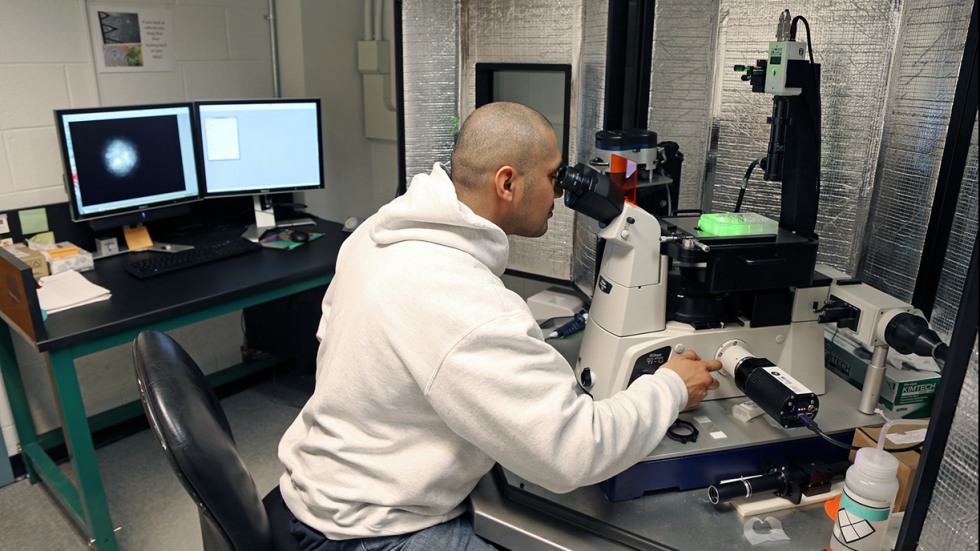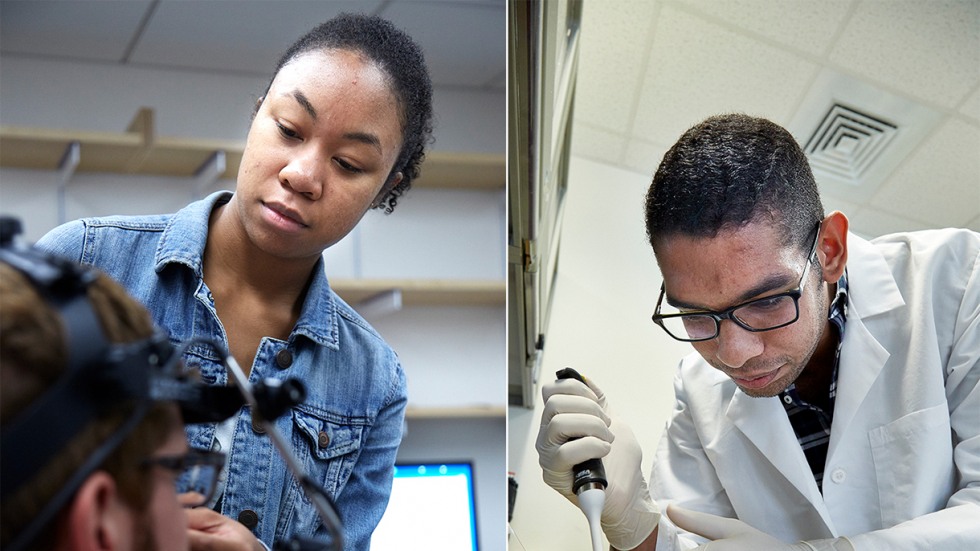PROVIDENCE, R.I. [Brown University] — In 1995, when Jason Sello was a junior at Morehouse College, he learned about the work of James Hogle, a researcher at Harvard Medical School and expert on how poliovirus and related viruses infect human cells.
Sello, a biology major, was intrigued. He wrote to Hogle: Were there any opportunities for Sello to work in his lab? The professor recommended that he seek a summer research position through the Leadership Alliance, a new consortium of universities based at Brown that offered research experiences to undergraduates from groups historically underrepresented in academia.
Sello applied, earned admission and spent the following summer in Cambridge.
“That summer at Harvard was a particularly important experience for me,” says Sello, now a chemistry professor at Brown. “It gave me more insight into what it would be like to earn a Ph.D. at a research university and also made me see Harvard as a place where I would feel comfortable pursuing graduate education.”
Sello proceeded to earn his Ph.D. in biophysics from Harvard before ultimately landing at Brown, where his research focuses on the development and mechanisms of drugs, including those directed toward viral infections. In 2011, he received the National Science Foundation’s top award for early-career scientists. In 2012, he received tenure; this summer, he became a full professor.
Sello is just one among the Leadership Alliance’s many success stories. Convened by then-Brown President Vartan Gregorian in 1992 as a partnership of 23 institutions, the Alliance, the executive office for which is housed at Brown, had a weighty mission: to address the stark shortfall of individuals from historically underrepresented groups who earn doctoral degrees and pursue research careers in academia, the public sector and industry.
Today, 25 years following its launch, the consortium continues to make steady progress toward its goal of diversifying the research world.
It has grown to 36 institutions and private industry partners who, to date, have provided more than 4,000 young scholars with research and networking experiences. More than 460 participants in the Alliance’s research programs have earned Ph.Ds., and another 388 are currently enrolled in doctoral programs.
Fifty-four percent of Alliance alumni who have earned doctoral degrees are employed in higher education, 58 percent of them in tenure-track positions. Sixty-five percent of those positions are at “R1” universities such as Brown, those classified as having the highest level of research activity.
From July 25 to 29, the Leadership Alliance celebrates its 25th anniversary at its annual research symposium in Hartford, Connecticut.
Summers of opportunity
The Leadership Alliance’s flagship program is its Summer Research Early Identification Program. Each summer, it matches at least 320 students from community colleges, liberal arts colleges and schools that have traditionally served underrepresented students with research experiences at 20 top research institutions, including all eight Ivy League institutions.
Students conduct research with professors across the disciplines, who mentor them through the experience. Participants receive a stipend along with funds to cover travel and housing expenses at their host institution. At the program’s culmination, students present their research at the Alliance’s annual symposium, which brings together all the summer research participants, as well as faculty and researchers from member institutions — nearly 600 people in total this year.
Many undergraduates who participate are first-generation college students who lack exposure to the research field and have little knowledge about academic career paths, says Medeva Ghee, executive director for the Leadership Alliance and an assistant professor at Brown. What they all have in common, she adds, is talent, motivation and a hunger to learn.
“These summer research opportunities at top-notch research universities give these incredibly bright students the tools they need — and a competitive edge — to apply successfully to top graduate school programs,” Ghee says.
Eight years ago, Robert Gutierrez was one such student. As a first-generation undergraduate at Santa Barbara City College in California, his path to the Leadership Alliance began when a professor in an animal biology class gave a lecture on how some lizards can regenerate severed tails. The professor noted how research on this trait might someday help doctors heal the injured limbs of humans.
Until that moment, Gutierrez had mostly thought about science as an exercise in memorizing facts — not as a collection of knowledge and tools to apply to real-life problems. His father was suffering from arthritis and osteoporosis. Could research help him, he wondered? And what did research actually entail?
Hoping to answer those questions, he ventured to a conference hosted by SACNAS, which works to increase the number of Chicanos, Hispanics and Native Americans attaining advanced degrees and pursuing careers in STEM fields. There, he happened upon a Leadership Alliance booth — and Ghee — and the rest is history.
“She told me all about the Leadership Alliance,” Gutierrez says, “and it made me think — this is something I want to do. This is something I can do.”
Gutierrez applied to the summer research program and landed a position in the lab of Eric Darling, an associate professor at Brown who conducts research on cell mechanics, stem cell biology and musculoskeletal tissue regeneration.
“Research was something I was never exposed to,” Gutierrez says. “I didn’t really know what it was. Not a lot of people I knew growing up even attended college. I learned so much that summer in the Darling Lab — and I had a blast. The lab was very welcoming.”
He returned to Brown the next summer to the lab of Qian Chen, an orthopedics professor at the Warren Alpert Medical School. By then, Gutierrez knew that he wanted to pursue his Ph.D. — he says he was able to leverage the connections he made and the support he received through the Alliance to transfer to a four-year school and take part in research opportunities at other institutions. Ultimately, he successfully applied to Brown’s doctoral program in biomedical engineering.
Now a rising third-year student in the program, Gutierrez recently earned a prestigious National Science Foundation fellowship to fund his research — once again in the Darling Lab.
“The Leadership Alliance really opened a door for me,” Gutierrez says. “It wasn’t just about learning the science; it helped build my confidence.”
Diversifying the academy
Students such as Gutierrez represent the future leaders that academia and the research workforce urgently need, Ghee says. But while the Leadership Alliance celebrates the achievements of each of its individual scholars, the broader goal of the consortium is to ultimately transform what academia and research look like.
By diversifying who is conducting research, universities not only advance equity, Ghee says, but position themselves to more effectively address the many complex questions that research poses. Some institutions — Brown included, through the work of its ambitious diversity and inclusion action plan — are more intentionally turning that principle into action, as they look to diversify their students, faculty and research staffs.
“The literature is clear that diverse research teams are more effective than homogenous ones at devising innovative responses to problems,” Ghee says. “That’s why diversity is so crucial in the research workforce and institutions of higher education. While there have been modest increases in students from underrepresented groups getting advanced degrees, it’s not nearly at the level that is representative of our country’s population.”
In 2016, as she hosted a Leadership Alliance forum on diversifying America’s research workforce, which featured Justice Sonia Sotomayor of the U.S. Supreme Court, Brown President Christina Paxson noted the even greater need now to advance the mission of the organization founded on Brown’s campus 25 years ago.
“As part of our commitment at Brown to strengthening diversity and inclusion on campus, we have greatly emphasized strategies for building an academic community that embodies the social and intellectual diversity of the world,” Paxson said. “The work of the Leadership Alliance is a great complement to efforts at Brown and at other research institutions, and this is a critical moment for us to use our leadership roles to influence higher education and our nation in a positive direction regarding the challenges and demands of diversity.”
Not only does diversity drive innovation and problem-solving, it also makes the focus of research more equitable, says Micah Holness, a Xavier University student who is spending her third summer at Brown conducting psychology research through the Leadership Alliance. This summer, she’s analyzing data for a study on mindfulness and smoking cessation in the lab of Brown researcher Ernestine Jennings.
Holness says the Alliance’s lens on diversity has helped her zero in on her professional goals. Research on many mental health disorders often centers less on people of color, she says; someday, she would like to study how treatments for a complex illness like schizophrenia might be improved for underrepresented populations.
“Racial stereotypes and gender stereotypes can affect treatment and diagnoses,” Holness says. “Diversifying who is doing research can make solutions more effective for a wider variety of people.”
Even in fields where the identities of individual scientists may be less directly applicable to decisions on what research questions to pose, Sello says the mentorship and opportunities to build networks offered by the Alliance are crucial — they enable young scholars of color to see themselves excelling at institutions and in professions where they are still in the minority.
“A cell is a cell is a cell, no matter what the identity of the people researching it is,” says Sello, who routinely mentors undergrads who often co-publish research with him, including two recent students from Morehouse, his alma mater. “But when I go to conferences and meetings, I see very few people who look like me. Young researchers need encouragement and a sense of community to fully engage in the scientific enterprise. The Leadership Alliance acknowledges that and has formalized structures to make sure that young researchers have those resources.”
The next 25 years
Since the Leadership Alliance’s launch, its programming has expanded to include support for participants as they proceed from undergraduate summer experiences to graduate study and early careers. The organization now facilitates online networking during the academic year for summer program alumni, for example. This year, the annual symposium includes a career development workshop for graduate students and postdoctoral scholars, as well as grant-writing coaching for faculty.
“We want to provide supports at each of the critical transitions of their career pathways,” Ghee says, “and provide them with a community of scholars from similar backgrounds so that they do become the leaders and role models we need in our 21st-century society.”
In the years to come, Ghee hopes to further scale up the Alliance’s work by expanding its reach to students at schools and industry outside the coalition. The Alliance is currently piloting undergrad workshops at Brown, Morehouse, Spelman College, the University of Chicago and Vanderbilt University to introduce undergraduates to the practice of research. As the workshops are refined, their curricula will become accessible to the public.
Ghee and her team have also forged partnerships with private industry, expanding research opportunities for Leadership Alliance scholars beyond academia. In 2012, Novartis Institutes for BioMedical Research, the research lab for the global pharmaceutical company Novartis, became an associate member of the Alliance —students can now apply for summer research opportunities there.
Ghee says she also hopes that the Leadership Alliance can serve as a model for more programs like it, both in the United States and abroad. She recently traveled to South Africa to present on the work of the Alliance.
“The goal now is to think more broadly about how we can be a convener and connector — how we can expand on our partnerships to increase the number of diverse students going into the research workforce,” Ghee says. “We have shown that the model works. But it can’t just be one program.”




